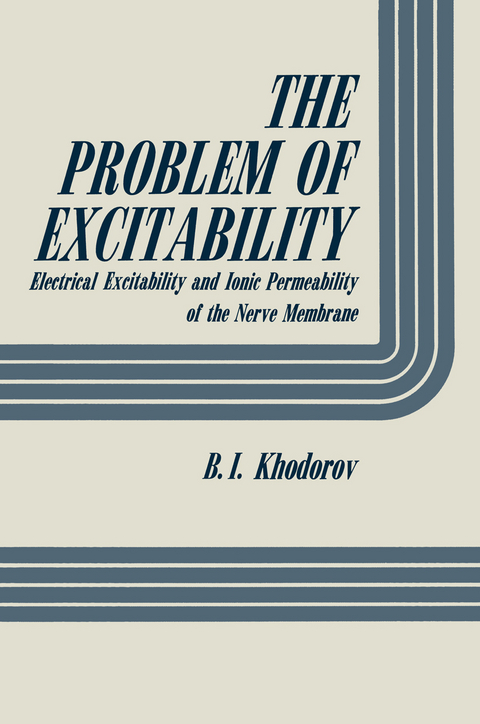
The Problem of Excitability
Springer-Verlag New York Inc.
978-1-4613-4489-6 (ISBN)
I. Excitability and Relationships Between the Initial and Critical Values of the Membrane Potential.- Changes in Vt associated with primary shifts of Er.- Changes in Vt resulting from a primary shift of Ec.- II. The Resting Potential.- III. Passive and Subthreshold Active Changes in the Membrane Potential.- Passive changes of membrane potential.- The local response.- IV. The Action Potential.- Historical.- Effect of changes in external and internal sodium and potassium ion concentrations on action potential generation.- Movement of ions through the membrane during activity.- Evidence for subdivision of the ionic currents.- Changes in ionic permeability.- Quantitative description of ionic currents.- V. Dependence of Action Potential Parameters on the Constants of Membrane Ionic Permeability.- Maximal sodium permeability $$/rm /overline P _{Na} $$Na.- Steady-state sodium inactivation (1 - h?) and time constant Th.- Reactivity of the sodium system (sensitivity of PNa to changes in membrane potential).- The threshold potential.- Maximal steepness of rise of the ascending phase of the action potential.- Amplitude of the action potential.- Duration of the action potential.- Time constant of sodium activation Tm.- Maximal potassium permeability $$/rm /overline P _K $$.- Reactivity of the potassium system (sensitivity of $$/rm /overline P _K $$ to changes in membrane potential).- Effects of an increase in reactivity of thepotassium system.- Effects of a decrease in reactivity of the potassium activating system.- Time constant of potassium activation (Tn).- Assessment of the character of changes in ionic permeability of the membrane from changes in the action potential.- VI. Analysis of Threshold Conditions of Stimulation and the Relationship Between the Threshold Current andThreshold Potential.- The strength versus duration curve.- Character of critical depolarization of the membrane during the action of pulses of current of different duration. Nature of the utilization time.- Relationship between the threshold current and the passive and active properties of the membrane.- VII. Role of the Rate of Change of the Stimulus. The Phenomenon of Accommodation.- The accommodation curve.- The mechanism of accommodation.- Minimal gradient as a function of the constants of ionic permeability of the membrane.- Accommodation and repetitive responses.- VIII. Cable Properties and Geometry of Excitable Structures and Parameters of Their Electrical Activity.- The propagated action potential.- Threshold conditions of stimulation.- The threshold potential.- The threshold current.- The strength versus duration curve.- Repetitive responses in a continuous axon.- Effects of stimulation of excitable structures with a functionally nonuniform membrane.- The relationship between the velocity of conductance of the action potential and the cable properties and excitability of the fiber.- Conduction of impulses along a nonuniform fiber.- Some properties of spike conduction from a medullated into a nonmedullated segment of a nerve fiber.- Compensatory changes in ionic currents during conduction of the impulse along a nonuniform fiber.- IX. Molecular Mechanisms of Ionic Permeability of the Excitable Membrane.- Functional architecture of the excitable membrane.- The hypothesis of ionic carriers.- The hypothesis of ion pores.- Hypotheses on conformational changes in the membrane.- Investigations of mechanisms of the changes in ionic permeability on artificial membranes.- Precipitation membranes.- Phospholipid membranes.- Conclusion.- Addendum.
| Zusatzinfo | XVIII, 330 p. |
|---|---|
| Verlagsort | New York, NY |
| Sprache | englisch |
| Maße | 152 x 229 mm |
| Themenwelt | Sachbuch/Ratgeber ► Natur / Technik ► Garten |
| Schulbuch / Wörterbuch ► Lexikon / Chroniken | |
| Geisteswissenschaften | |
| Naturwissenschaften ► Physik / Astronomie ► Angewandte Physik | |
| Sozialwissenschaften | |
| ISBN-10 | 1-4613-4489-1 / 1461344891 |
| ISBN-13 | 978-1-4613-4489-6 / 9781461344896 |
| Zustand | Neuware |
| Haben Sie eine Frage zum Produkt? |
aus dem Bereich


